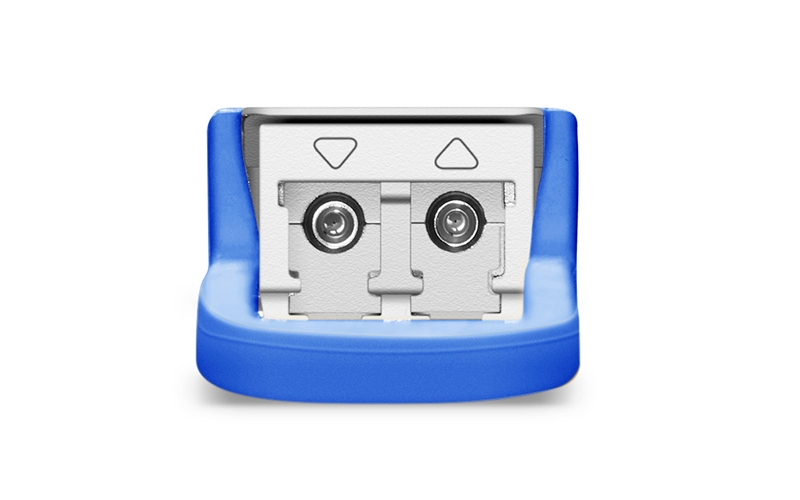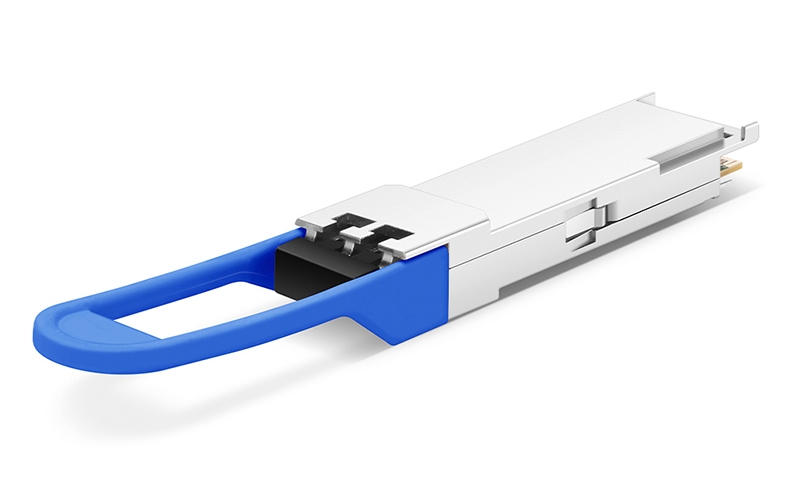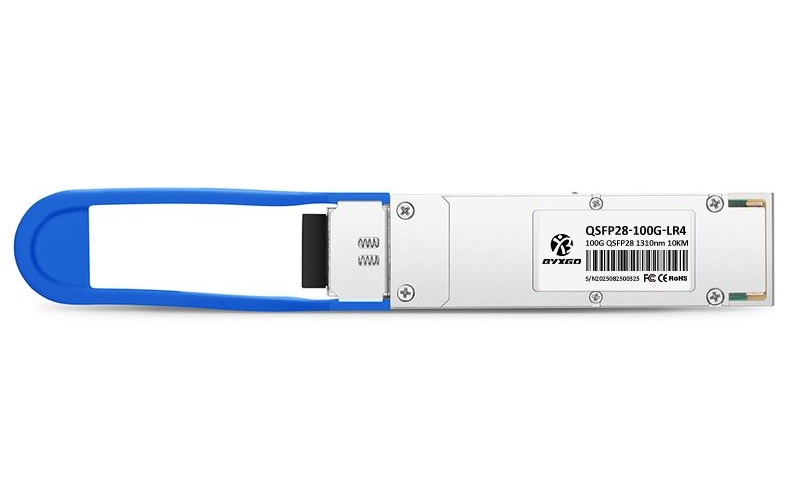What Is QSFP28 LR4? In-Depth Analysis of Long-Distance 100G Optical Modules

QSFP28 LR4 is a crucial technology for delivering reliable, long-distance 100G connectivity in enterprise and data center networks. The market is complex, and choosing the right module that meets your cost, performance, and compatibility needs is difficult. This article thoroughly reviews the core technologies of LR4, provides clear selection criteria, offers helpful tips for deployment, explores troubleshooting strategies, considers the changing landscape, and shows LR4 in a larger context. Engaging with this material will provide readers with the tools to make more informed decisions that will maximize the effectiveness and efficiency of their high-speed fiber infrastructure.
100G Long-Haul Transmission Explained: Core Technology of QSFP28 LR4
A standard QSFP28 LR4 module uses four discrete 25G optical lanes and achieves 100G transmission using wavelength division multiplexing (WDM). Think of these four data streams as four distinct “colors” of light, with each color being carried by light traveling at a slightly different wavelength in the 1310nm range. WDM combines the four “colors” into one single dense signal, which is transmitted simultaneously across one strand of single-mode fiber. The use of WDM allows for more data to be transferred over greater distances without compromising signal quality.
In summary, working with 1310nm represents a happy medium for distance and signal integrity. This wavelength is demonstrated to have lower attenuation in single-mode fiber, making it possible for the QSFP28 LR4 to achieve up to 10 kilometers without the need to regenerate the signal.
The core parameters that play into the performance of the LR4 module are:
- Optical power output: must provide enough power to reach the distance requirement but also remain below the damage threshold.
- Receiver sensitivity: the minimum power required to reliably detect the signal without incurring bit errors in sending and receiving.
- Spectral efficiency: the ability to transmit the maximum amount of data in a small percentage of the overall wavelength spectrum.
Together, these specifications determine if LR4 modules can support longer 100G connections over distance and ensure the network provides speedy and consistent performance, helping to support data center backbone and enterprise use cases.

How Does QSFP28 LR4 Compare Technically to SR4 and CWDM4 Modules?
While the QSFP28 LR4, SR4, and CWDM4 modules all clearly support 100G transmissions, they greatly differ in terms of technology, fiber types, and their intended applications.
Wavelength and Fiber Type:
- The LR4 consists of four wavelengths around 1310nm multiplexed together on a single-mode fiber, which works up to about 10km.
- The SR4 contains four lanes at 850nm over multimode fiber for distances of 100m-150m at the absolute maximum.
- The CWDM4 wavelength multiplexes several wavelengths for transmission over single-mode fiber in the 1310nm range (the other side of the spectrum), which is expected to reach up to 2km, but this is usually, though not always, much more cost-effective than the LR4.
Power:
The LR4 module will typically consume, and require, considerably more power and cooling than the SR4 as a result of the much longer distance electronics and single-mode optics. The CWDM4 will generally be in the middle of these configurations in terms of cost and reach for power consumption, although this leads to increased complexity.
Cost:
The SR4 is the cheapest module in terms of cost for short, high-density connections but is not a practical option for long runs other than for cost considerations. The cost of the LR4 is significantly higher due to much longer distances and increasing complexity. The CWDM4 is a mid-range cost option, but this may not consistently be the case as regional links require significantly lower costs than LR4 for up to MW lengths depending on their distance.
Performance and Spectral Efficiency:
The LR4 has superior spectral efficiency for backbone and long-haul links, while the SR4 is most suitable for dense, short-reach environments (one consideration would be that there is no adjustment on the visual or read capabilities in the reach environment). The CWDM4 would be used in specific metro or data center edge scenarios, and while distance and speed affect overall spectral efficiency, the speed-to-cost ratio will result in moderate performance.
Overall:
The QSFP28 LR4 has been purposefully designed to be a cost-effective, mid-to-long haul 100G link with acceptable reliability for performance over 10km of single-mode fiber. The SR4 is useful for very short, high-density configurations, while the CWDM4 could be used as a less expensive option up to SR4 lengths, but less than LR4 distances for the scenarios. Awareness of the differences allows for a purposefully aligned use of technology according to needs.

How to Choose the Right QSFP28 LR4 Module: Parameters and Compatibility
When choosing a QSFP28 LR4 module, there are a few important factors to consider to get the best long-distance 100G link reliability. First, you need to consider the link length to be sure the module has been qualified for that reach. LR4 modules are typically specified up to 10 kilometers over single-mode fiber; exceeding the stated reach will result in link degradation, so if a link is not very long, don’t attempt to overspec it. Next is the verified compatibility of the fiber type.
The QSFP28 LR4 will operate utilizing single-mode fiber since it uses the 1310nm wavelength. Attempting to use it with multimode fiber will result in an unworkable transmission failure. Power is an additional specification to consider. Optical modules have a defined transmit (Tx) power and a defined receive (Rx) sensitivity, so verifying that your networking equipment can utilize both of these parameters is key to ensuring a functioning link budget and avoiding errors.
You also need to consider switch compatibility and suggested firmware. Each manufacturer has a list of supported transceivers, or compatible SFP transceivers, often certified by EEPROM code inside the module. Validating the EEPROM with the vendor and your networking device’s firmware version, in conjunction with the listed specifications, goes a long way toward ensuring that any compatibility issues do not present themselves after installation.
Last, but certainly not least, obtain vendor certification that states the module is authentic and accepted warranty. While doing this, key parameters to consider when searching for modules include:
- Maximum distance
- Wavelength/fiber type
- Optical power budget
- Module power consumption
- Firmware/hardware compatibility
With the multi-dimensional checklists above, you will be sure that your QSFP28 LR4 module will be just right for your network environment, limiting downtime while maximizing ROI.
Exclusive: Side-by-Side Comparison of Top QSFP28 LR4 Modules
It is a great idea to be familiar with the subtly different specifications and uses of QSFP28 LR4 modules from the different top suppliers before you make a decision. Here, we’ve put together a comparison of Cisco, Finisar, and Arista, which are all top suppliers of high-quality 100G optics.
| Module Model | Wavelength | Max Distance | Fiber Type | Power Consumption | Typical Use Cases | Approximate Price Range |
| Cisco GLC-100G-LR4 | 1310 nm | 10 km | Single-mode fiber | Moderate | Campus backbones, metro | High |
| Finisar FTL410QE2C | 1310 nm | 10 km | Single-mode fiber | Moderate-Low | Data centers, enterprise | Moderate |
| Arista QSFP-100G-LR4 | 1310 nm | 10 km | Single-mode fiber | Low | Cloud networks, service providers | Moderate-High |
- Wavelength and Distance: Each of the three modules operates within a wavelength of 1310 nm on single-mode fiber, providing a common distance extension of 10 kilometers.
- Power Rating: Arista modules traditionally have slightly lower power ratings, which is favorable for high-density applications.
- Applications: Cisco modules have great vendor support for large customer campus and metro environments; Finisar offers a good balance of price and performance for enterprise deployments; Arista modules are designed for cloud and service provider trade-offs with an emphasis on scale.
- Pricing: Pricing usually varies with the vendor, reputation, and support services, but also varies with vendor support options; Finisar is typically less costly, while Cisco typically demands a higher price due to a high level of trust in the brand.
However, this comparison sets a stage for a network architect or buyer to quickly see which LR4 module works best with the technical requirements, budget, and operational context of deployment. The side-by-side comparison of all factors also mitigates the decision-making process of ensuring 100G long-distance connectivity with the least amount of risk.
How to Avoid Common Purchasing Pitfalls: Compatibility Checklist
To prevent expensive mistakes, be sure to verify these important factors to help you assess overall compatibility before purchasing QSFP28 LR4 modules. First, always check for vendor certifications to affirm the module has been certified for use as an authentic third-party module certified to work with that vendor. Also, check that the EEPROM codes embedded in the module are the same codes your switch or device recognizes. This will ensure that the module can be recognized, not just allowed as an acceptable QSFP28 LR4 module the hardware can use.
Second, review the supported transceiver list for your hardware and make sure the firmware being used supports the module. It is also prudent to purchase transceivers from authorized vendors or verified manufacturers to ensure quality and warranty options. Each of these common-sense checks will protect and support the overall performance of the network, while at the same time minimize the challenge of troubleshooting and provide maximum ROI.

Perfect Deployment: Installation and Troubleshooting QSFP28 LR4 Modules
Meticulous installation of the QSFP28 LR4 module is the first step in guaranteeing flawless performance. The key to successful installation begins before you insert the module. Like other fiber optic connectors, the end faces of the fiber must be clean, free from dust and oils. You may be surprised how much dust and oil transfer from your fingers when connecting fiber optics! Dust and other particulates are a contributing factor to signal attenuation.
Be sure to clean fiber end faces very well using a lint-free wipe with approved solvents (preferably) or IPA. Ensure that conscientious insertion occurs with the QSFP28 modules. They will click into place when they are fully inserted. Employ gentleness, but do not be apprehensive. Avoid crushing optics or damaging connectors. Note that excessive force is not necessary for installation.
Environmental aspects must be accounted for. Be sure to select modules that are graded for your deployment environment. Commercial-grade QSFP28 LR4 modules enable connections in controlled environments such as data centers reliably. If fiber connector noise or vibration is present, be sure to use industrial-grade QSFP28 optics.
Preventive maintenance is required to prevent performance signal integrity and module durability issues. Include regular cleaning of fiber connectors as part of your maintenance routine and run health diagnostics regularly using your switch or router management interface. Regularly monitoring environmental parameters (temperature, optical power, error counts, etc.) allows you to identify early issues of degradation or failure—applying preventive techniques to eliminate possible failures in performance. The key to reducing unexpected service interruptions and downtime through best practices in maintenance over time is the continuous observation and monitoring of equipment.
Deployment Challenges and Solutions: Exclusive Case Study
A large data center was plagued by continual latency spikes and irregular link failures on its existing 100G network. The original deployment used short-reach modules almost exclusively and connected several links beyond their maximum distances, creating unreliable data transfer and escalating operational costs due to repeated troubleshooting and hardware replacement.
To identify the source of network reliability issues, the network team performed a full audit on the fiber paths and link requirements. Following the audit, they established a tiered strategy using QSFP28 LR4 modules for all links up to a 10 km distance over single-mode fiber. The shorter links maintained the SR modules properly deployed.
Once the LR4 modules were installed and operational, the data center realized a 25 percent improvement in latency and 50 percent less downtime on the network. Additionally, operational expenditures were reduced by approximately 15 percent due to decreased power consumption and fewer hardware failures over time.
This case identifies the importance of having the right modules for each segment of the network while providing clear benefits around LR4 technology for mid-to-long range 100G links. The facility was able to improve latency and stability of the network by matching existing infrastructure and traffic patterns, within the limits of module capabilities, while improving cost efficiency.
Expert Troubleshooting: CLI Commands and Fault Diagnosis
Significant fault indicators can be no link; no link may stem from poor module seating or dirty connectors. Other indicators can be high error rates; for example, a high error rate means there may be damage or issues with fiber or power.
Useful diagnostic commands are: show interfaces transceiver detail (Cisco) and show interfaces diagnostics optics (Juniper). Both commands provide useful values on Tx/Rx optical power, temperature, and voltage for various optics values. Understanding what this output is telling us will help foretell potential problems, e.g., low Rx power is likely to be attributed to contaminated connectors; abnormal Tx power could indicate problematic optics; high temperature may be attributed to hardware stress, environmental conditions, etc.
If we know how to assess these, we are well prepared to isolate faults efficiently while minimizing the impact of any downtimes in the network.
Evolution of 100G and Beyond: Trends in Optical Modules
The development of optical technology is moving to the next level beyond 100G, and 200G and 400G SR/LR/ER modules are being deployed in larger networks. These modules have many of the same fundamental concepts as the QSFP28 LR4 — single-mode fiber in the same wavelength bands and backward compatibility.
The primary effort has been concentrated on developing improved diagnostic capabilities — richer telemetry data offers more options for proactive network management. Power efficiencies limit the increased load of cooling on each unit, which is important in high-density data centers. In addition, the additional form factor options provide the switches with greater port densities to add bandwidth without taking up rack space.
The advisory nature of the development provides additional comfort for the investment in QSFP28 LR4 modules and ease of transition as demand and requirements increase.

Preparing for Future Upgrades: Strategic Considerations
Developing a growth strategy for your new network means aligning your current LR4 deployment with future scalable, next-gen infrastructure. Forecast your anticipated bandwidth requirements, and make sure your actual physical cabling infrastructure can accommodate physical lambda upgrades to LR4-compatible 200G and 400G optics.
If you understand the trade-off between system CAPEX costs today and future upgrades and scalability, you will minimize your capital expenditures over the life of the network without going through multiple expensive upgrades of an entirely new physical infrastructure. Investing in modular switches with firmware upgrades and verifying vendor roadmaps to ensure that any new standards can be seamlessly integrated into your network is a better approach to future planning. Planned upgrades allow you to conserve capital investment while meeting your network’s growing traffic demands going forward.
Conclusion
QSFP28 LR4 modules represent a crucial component in achieving reliable and cost-effective long-distance 100G optical transmissions. The multiplexing technology, combined with the use of the 1310nm wavelength over single-mode fiber, provides a solid link distance capability (up to 10 kilometers) between performance and cost.
Understanding the technology behind LR4 modules, what to buy (and not buy) in compatible and certified modules, and deploying and maintaining best practices for the management of the technology, combined, establishes the basis for a successful and productive network system for the long-term.
Moreover, anticipating future technology and upgrades will ensure that the investments you make at this procurement stage, over time, will remain relevant and useful to your organization. The comparisons presented in the study, the case studies, and the troubleshooting information have provided the necessary tools for you to utilize to maximize the use of your infrastructure as dependable and exact, and to ensure that your infrastructure has the capability to maintain performance and scalability to continue to support evolving data consumption.
